
Below are selected articles published on this site in December 2013 and January 2014. We hope you will find some of interest.
Articles here have been moved from the Recent Articles page and are in reverse chronological order.
12 January 2014
Unfinished Business
Masterspy, Tony Wood, in his latest blog, featured a Scimitar vase sold on eBay in December. It was the version with a matt ground, pattern number 3652. He said, and I agreed, that it was unfinished, but several people disagreed.
The images supplied by the vendor were poorly lit and out of focus so it was not easy to see missing parts of the decoration. We have had the images digitally enhanced so it is easier to see the incomplete decoration. Can you spot the difference from the pictures below? The first image shows the inside of a bowl with the pattern in its full glory; the pictures below the bowl show three views of the vase in question.
The images supplied by the vendor were poorly lit and out of focus so it was not easy to see missing parts of the decoration. We have had the images digitally enhanced so it is easier to see the incomplete decoration. Can you spot the difference from the pictures below? The first image shows the inside of a bowl with the pattern in its full glory; the pictures below the bowl show three views of the vase in question.
Spot the difference
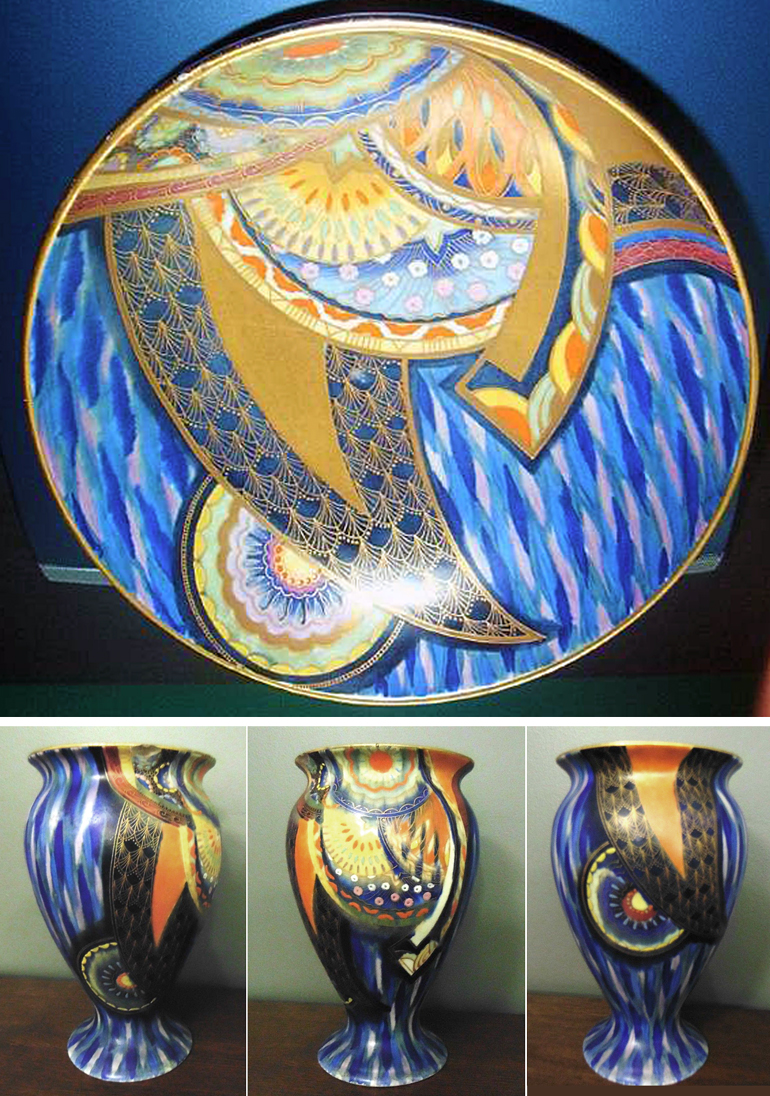
Top picture Scimitar 3652 bowl interior. Bottom pictures, three views of the unfinished vase in question.
On the vase, notice that the filled in, or solid areas of gold are missing, notably on the "blade" of the "scimitar", though here it has been replaced with orange lustre, though elsewhere no attempt had been made complete the decoration. Other elements are also incomplete.
So why was the vase not finished? This will be because an uncorrectable fault had developed during firing; no doubt close examination would reveal one.
Another question might be why was the filled in gold replaced with orange on the "blade"? I would suggest, bearing in mind these best wares were so expensive to produce, that the pattern was patched up so it could be sold as a second, thereby recovering some of the costs of production. After all even incomplete the vase is still eye catching.
I'm always a little wary of items on eBay with blurred and poorly exposed images, which can be an indication that the vendor is trying to hide something, not that for one moment am I suggesting this is the case here. ❑
So why was the vase not finished? This will be because an uncorrectable fault had developed during firing; no doubt close examination would reveal one.
Another question might be why was the filled in gold replaced with orange on the "blade"? I would suggest, bearing in mind these best wares were so expensive to produce, that the pattern was patched up so it could be sold as a second, thereby recovering some of the costs of production. After all even incomplete the vase is still eye catching.
I'm always a little wary of items on eBay with blurred and poorly exposed images, which can be an indication that the vendor is trying to hide something, not that for one moment am I suggesting this is the case here. ❑
Scroll down for other articles.
26 December 2013
Boxing Day
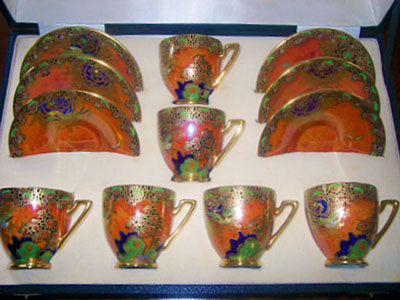
PARADISE BIRD & TREE with CLOUD 3154 in silk lined
presentation box.
Carlton Ware, like other potteries, offered their more expensive wares in silk lined presentation boxes. Coffee sets were sometimes sold in this way, as on the right, adding to their desirability and expense.
The earliest known presentation box is for a cruet with hallmarked Sterling silver mounts dated 1923, shown below.
The earliest known presentation box is for a cruet with hallmarked Sterling silver mounts dated 1923, shown below.

PENDANT BUBBLES 2783 cruet in presentation box.
The retailers name and address was often printed in gold to the silk that lined the lid indicating that it was a special order item for the more prestigious shop or store.
Boxing Clever
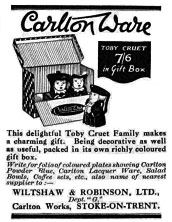
Advertisement for boxed
TOBY cruet c.1928.

TOBY cruet c 1928 no box.
Today, we are so used to finding so many things in gift boxes but in the 1920s, as far as the pottery world was concerned, this was unusual. Carlton Ware appears to have been one of the first Staffordshire potteries to present their wares in gift boxes made from printed cardboard. This was a clever move, for not only did they look attractive but also gave protection during transit, especially when there was more than one item.
To date, the first known gift box used by Carlton Ware was for the TOBY cruet, which was introduced in 1926. An advertisement from c.1928 is shown on the left. Few boxes survive, I have seen only one and as the advertisement says it was richly coloured, as was its contents. The price of the cruet was 7 shillings six pence (32p) and at that time a typical pottery worker earned about £1 15 shillings (£1.75p) a week.
To date, the first known gift box used by Carlton Ware was for the TOBY cruet, which was introduced in 1926. An advertisement from c.1928 is shown on the left. Few boxes survive, I have seen only one and as the advertisement says it was richly coloured, as was its contents. The price of the cruet was 7 shillings six pence (32p) and at that time a typical pottery worker earned about £1 15 shillings (£1.75p) a week.
Many more boxed sets were to follow as Carlton Ware extended its increasingly popular fruit and floral embossed wares. Like the box for TOBY cruet, these were made from cardboard and had attractive lids. They were especially suitable for the small jam or butter dishes with a spoon or knife.
Top of the Box
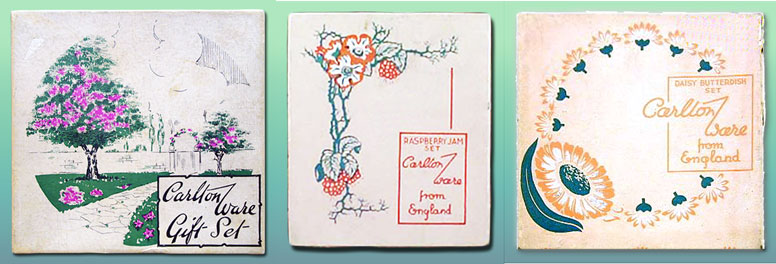
Box tops used for Fruit & Floral Embossed wares.
In the illustration above, the two box tops on the right, which say from England, appear to have been made for the overseas market. Notice the contents are named on their lids and that the illustration relates to the design, RASPBERRY and DAISY respectively. The box on the left was used for a wide range of items and the contents were indicated by a rubber stamped name on the base.
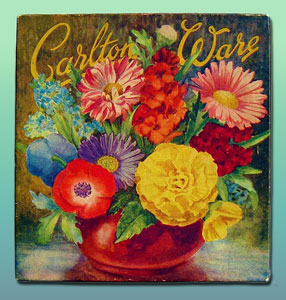
Box top printed in full colour.

Water Lily open jam & spoon.
The use of gift boxes must have proved highly successful because a full colour version was then introduced, shown left. This continued to be used well into the 1950s and possibly beyond. As with the box top above this was used for many ranges. One wonders if the art work for all lids was done by Violet Elmer?
Larger boxes were also used to fit various other items. Some were covered in faux shagreen, embossed silver foil, as well as abstract patterns. This suggests that Carlton Ware might have used several suppliers.
Whatever the contents if the item was being given as a present, the recipient can only have been pleased to see what lay inside.
Let's open some....
Larger boxes were also used to fit various other items. Some were covered in faux shagreen, embossed silver foil, as well as abstract patterns. This suggests that Carlton Ware might have used several suppliers.
Whatever the contents if the item was being given as a present, the recipient can only have been pleased to see what lay inside.
Let's open some....
Open the Box
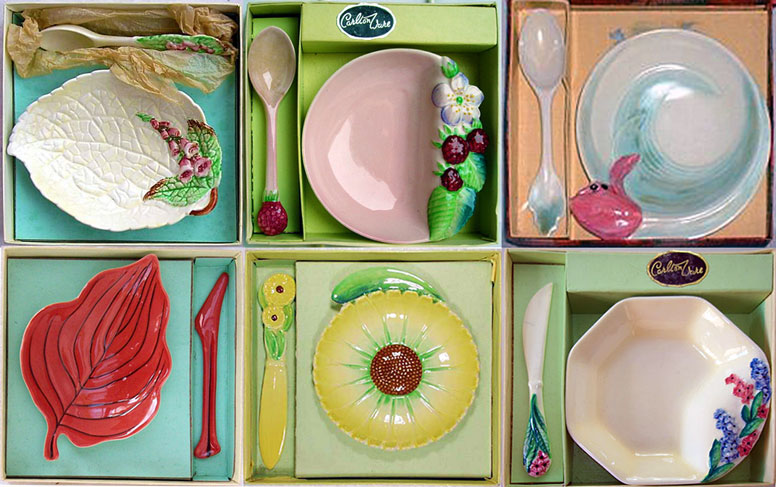
Selection of butters with knives and jam dishes with spoons. Top row FOXGLOVE, RASPBERRY and TULIP.
Bottom row PINSTRIPE, DAISY and FORGET-ME-NOT.
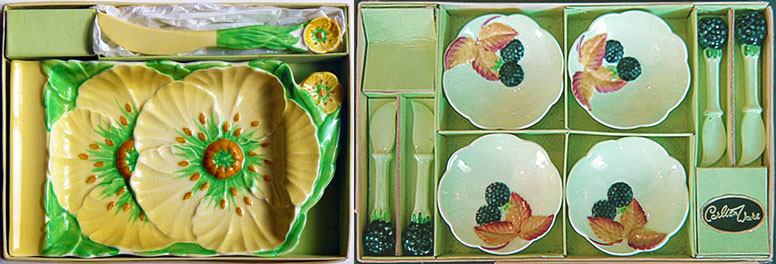
Larger boxes. Left - BUTTERCUP cheese plate & knife. Right - BLACKBERRY butter pats & knives.
Tea Box
Large orders, especially to overseas, were sent to retailers in barrels or tea boxes with ware packed in straw.
Packing properly was a highly skilled occupation.
Packing properly was a highly skilled occupation.
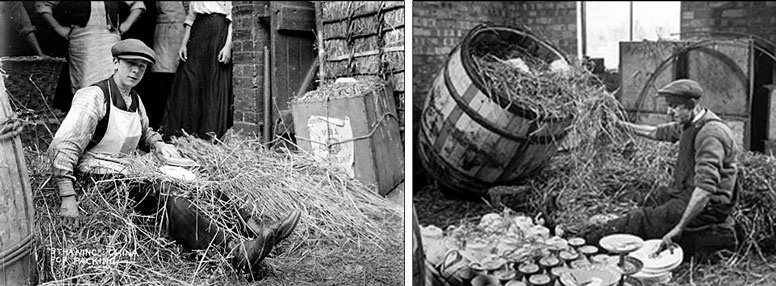
In these images, from around 1910, ware is being packed in the yard of the pottery, presumably only in dry weather. Sometimes the barrels were too large to get through a shop door so had to be unpacked on the pavement.
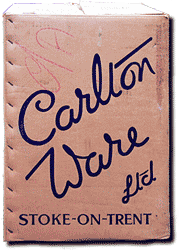
Carlton Ware corrugated
cardboard box.
Corrugated Cardboard Box
In more recent times, the lighter and much more convenient cardboard boxes were used. We take these so much for granted today. The corrugated cardboard from which they were made was invented in the 1890s by Scottish born Robert Gair in America but it was some time before this new laminated material was trusted and it probably wasn't until the 1920s that their use took off and that they were made on any scale. Pottery and glass makers may have been among the first to make use of them.
We don't know when CW began to use the corrugated box but it is likely to have been in the 1930s, at the earliest. Not surprisingly, few survive though one is shown on the left, which Terry Wise discovered recently and is in extraordinarily good condition. I know of only two others less so. The label on it tells us that it had been sent by rail in 1967.
Who would have thought that there was so much to say about the box! ❑
© Harvey Pettit 2013
To comment on this article . If you have a box that is not shown above please send a picture.
Note - If you do not use an email client such as Microsoft Outlook or Windows Live Mail and use webmail instead email links like the one above will not work, so connect to your webmail and use my email address which is harvey followed by the at symbol, followed by carlton ware world dot com with no spaces. (written this way to stop spam bots harvesting my email address).
We don't know when CW began to use the corrugated box but it is likely to have been in the 1930s, at the earliest. Not surprisingly, few survive though one is shown on the left, which Terry Wise discovered recently and is in extraordinarily good condition. I know of only two others less so. The label on it tells us that it had been sent by rail in 1967.
Who would have thought that there was so much to say about the box! ❑
© Harvey Pettit 2013
To comment on this article . If you have a box that is not shown above please send a picture.
Note - If you do not use an email client such as Microsoft Outlook or Windows Live Mail and use webmail instead email links like the one above will not work, so connect to your webmail and use my email address which is harvey followed by the at symbol, followed by carlton ware world dot com with no spaces. (written this way to stop spam bots harvesting my email address).
Carlton Ware World © Copyright 2013/14. All rights reserved.